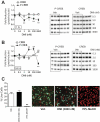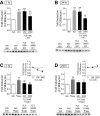Desipramine reduces stress-activated dynorphin expression and CREB phosphorylation in NAc tissue
- PMID: 19106229
- PMCID: PMC2684917
- DOI: 10.1124/mol.108.051417
Desipramine reduces stress-activated dynorphin expression and CREB phosphorylation in NAc tissue
Abstract
The nucleus accumbens (NAc) is a critical brain area for reward and motivated behavior. Accumulating evidence suggests that altered function of the transcription factor cAMP response element binding protein (CREB) within the NAc is involved in depressive behavior. In rats, stress activates CREB within the NAc, and elevation of CREB expression in this region produces depressive-like behaviors that are accompanied by activation of CREB-regulated target genes. The depressive-like behaviors seem to be due, at least in part, to CREB-mediated increases in dynorphin function, because they are mimicked by kappa-opioid receptor (KOR) agonists and attenuated by KOR antagonists. We hypothesized that if CREB-mediated dynorphin expression in the NAc contributes to depressive behavior, then antidepressants might reduce dynorphin function in this region. Here, we demonstrate that desipramine (DMI), a norepinephrine reuptake inhibitor that has been used for decades to treat clinical depression, blocks swim stress-induced activation of prodynorphin (encodes dynorphin) in the NAc. In primary cultures of NAc and striatum, DMI decreases basal and stimulated CREB phosphorylation by causing reductions in intracellular calcium (Ca(2+)) availability that are independent of norepinephrine or other monoaminergic inputs, identifying a potential mechanism for alterations in CREB-mediated gene expression. Fluoxetine (FLX), a selective serotonin reuptake inhibitor, has similar effects in culture, suggesting a common intracellular effect of these antidepressants. These findings raise the possibility that a therapeutically relevant mechanism of action of DMI occurs through attenuation of CREB-mediated gene transcription, which is mediated via previously uncharacterized mechanisms that occur directly within the NAc.
Figures





Similar articles
-
Roles of nucleus accumbens CREB and dynorphin in dysregulation of motivation.Cold Spring Harb Perspect Med. 2013 Feb 1;3(2):a012005. doi: 10.1101/cshperspect.a012005. Cold Spring Harb Perspect Med. 2013. PMID: 23293139 Free PMC article. Review.
-
Altered responsiveness to cocaine and increased immobility in the forced swim test associated with elevated cAMP response element-binding protein expression in nucleus accumbens.J Neurosci. 2001 Sep 15;21(18):7397-403. doi: 10.1523/JNEUROSCI.21-18-07397.2001. J Neurosci. 2001. PMID: 11549750 Free PMC article.
-
Inhibition of cAMP response element-binding protein or dynorphin in the nucleus accumbens produces an antidepressant-like effect.J Neurosci. 2002 Dec 15;22(24):10883-90. doi: 10.1523/JNEUROSCI.22-24-10883.2002. J Neurosci. 2002. PMID: 12486182 Free PMC article.
-
Activation of CREB in the nucleus accumbens shell produces anhedonia and resistance to extinction of fear in rats.J Neurosci. 2011 Feb 23;31(8):3095-103. doi: 10.1523/JNEUROSCI.5973-10.2011. J Neurosci. 2011. PMID: 21414930 Free PMC article.
-
Kappa-Opioid Antagonists for Psychiatric Disorders: From Bench to Clinical Trials.Depress Anxiety. 2016 Oct;33(10):895-906. doi: 10.1002/da.22500. Depress Anxiety. 2016. PMID: 27699938 Free PMC article. Review.
Cited by
-
Comparison of the kappa-opioid receptor antagonist DIPPA in tests of anxiety-like behavior between Wistar Kyoto and Sprague Dawley rats.Psychopharmacology (Berl). 2010 Jun;210(2):295-302. doi: 10.1007/s00213-010-1832-9. Epub 2010 Apr 6. Psychopharmacology (Berl). 2010. PMID: 20369354 Free PMC article.
-
Repeated exposure to the κ-opioid receptor agonist salvinorin A modulates extracellular signal-regulated kinase and reward sensitivity.Biol Psychiatry. 2011 Oct 15;70(8):744-753. doi: 10.1016/j.biopsych.2011.05.021. Epub 2011 Jul 14. Biol Psychiatry. 2011. PMID: 21757186 Free PMC article.
-
Kappa opioid receptor signaling in the basolateral amygdala regulates conditioned fear and anxiety in rats.Biol Psychiatry. 2011 Sep 1;70(5):425-33. doi: 10.1016/j.biopsych.2011.03.017. Epub 2011 Apr 30. Biol Psychiatry. 2011. PMID: 21531393 Free PMC article.
-
Roles of nucleus accumbens CREB and dynorphin in dysregulation of motivation.Cold Spring Harb Perspect Med. 2013 Feb 1;3(2):a012005. doi: 10.1101/cshperspect.a012005. Cold Spring Harb Perspect Med. 2013. PMID: 23293139 Free PMC article. Review.
-
κ-Opioid receptors within the nucleus accumbens shell mediate pair bond maintenance.J Neurosci. 2012 May 16;32(20):6771-84. doi: 10.1523/JNEUROSCI.5779-11.2012. J Neurosci. 2012. PMID: 22593047 Free PMC article.
References
-
- American Psychiatric Association (2000) Diagnostic and Statistical Manual of Mental Disorders, 4th ed. rev. American Psychiatric Press, Washington DC.
-
- Baldessarini RJ (2006) Drug therapy of depression and anxiety disorders, in The Pharmacological Basis of Therapeutics (Brunton LL, Lazo JS and Parker KL eds) pp 429-459, McGraw-Hill, New York.
-
- Bals-Kubik R, Ableitner A, Herz A, and Shippenberg TS (1993) Neuroanatomical sites mediating the motivational effects of opioids as mapped by the conditioned place preference paradigm in rats. J Pharmacol Exp Ther 264 489-495. - PubMed
-
- Berton O, McClung CA, Dileone RJ, Krishnan V, Renthal W, Russo SJ, Graham D, Tsankova NM, Bolanos CA, Rios M, et al. (2006) Essential role of BDNF in the mesolimbic dopamine pathway in social defeat stress. Science 311 864-868. - PubMed
-
- Cai Z and McCaslin PP (1992) Amitriptyline, desipramine, cyproheptadine and carbamazepine, in concentrations used therapeutically, reduce kainate- and N-methyl-d-aspartate-induced intracellular Ca2+ levels in neuronal culture. Eur J Pharmacol 219 53-57. - PubMed
Publication types
MeSH terms
Substances
Grants and funding
LinkOut - more resources
Full Text Sources
Other Literature Sources
Miscellaneous

